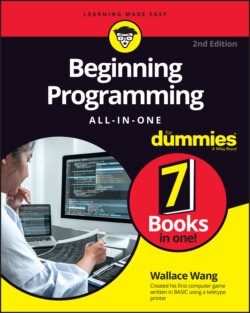Читать книгу Beginning Programming All-in-One For Dummies - Wallace Wang - Страница 44
Isolating data
ОглавлениеObject-oriented programming avoids the problem of not knowing the purpose of code by combining data and the commands that manipulate them into a single entity called (surprise!) an object. With a well-designed object-oriented program, each object models part of the real-life problem so it’s easier to understand the purpose of the code inside that object.
So, if you were designing a program to launch a rocket to the Moon, object-oriented programming would let you divide the program into objects. One object might be the rocket, a second object might be the Moon, and a third object might be the Earth.
You can also divide a large object into smaller ones. So the rocket object might be divided into an engine object and a guidance object. The engine object could be further divided into a fuel pump object, a nozzle object, and a fuel tank object.
Suppose you wrote a program to calculate a rocket's trajectory to the Moon, and the engineers suddenly designed the rocket with a more powerful engine? With object-oriented programming, you could just yank the engine object out of your program, rewrite or replace it, and plug it back into the program again.
In structured programming, modifying the program to reflect a new rocket engine would mean finding the program commands that manipulate the data that represents the engine’s thrust, and then making sure that new data gets fed into the program at the proper location and still works with any other program commands that also handle that same data. (If the explanation in this paragraph sounded confusing and convoluted to you, that just shows you the less-than-intuitive problem of modifying a structured program versus an object-oriented program.)
